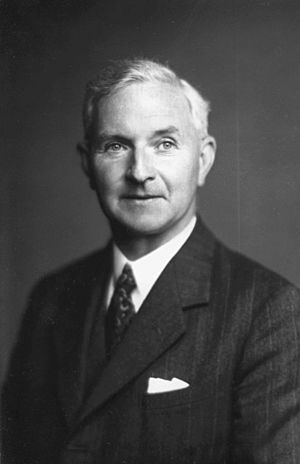John Lennard-Jones facts for kids
Quick facts for kids
John Lennard-Jones
|
|
|---|---|
 |
|
| Born |
John Edward Jones
27 October 1894 Leigh, Lancashire, England
|
| Died | 1 November 1954 (aged 60) Stoke-on-Trent, England
|
| Alma mater | University of Manchester |
| Known for | Lennard-Jones potential LCAO |
| Spouse(s) |
Kathleen Lennard
(m. 1925) |
| Children | 2 |
| Awards |
|
| Scientific career | |
| Fields | Mathematician |
| Institutions |
|
| Doctoral advisor | Ralph Howard Fowler |
| Doctoral students |
|
Sir John Edward Lennard-Jones (27 October 1894 – 1 November 1954) was a very important British scientist. He was a mathematician and a professor who taught about how chemicals and physics work. He taught at the University of Bristol and later at the University of Cambridge. Sir John was a key person in creating modern computational chemistry. This field uses computers to understand how chemicals behave. He also helped develop theoretical chemistry, which uses ideas and math to explain chemical reactions.
Contents
His Early Life and School
John Edward Jones was born on 27 October 1894. He grew up in a town called Leigh in Lancashire, England. His father, Hugh Jones, worked in insurance. John went to Leigh Grammar School. After that, he studied at the University of Manchester. In 1915, he finished his degree in mathematics with top honors.
His Amazing Career
Sir John Lennard-Jones is famous among scientists for his work on tiny particles. He studied how molecules are built and how they stick together. He also looked at valency, which is about how atoms connect to form molecules. His ideas about the forces between molecules are still very important today.
Understanding Atoms and Molecules
In 1929, he published a paper that changed how people thought about these topics. Much of the research in chemistry for many years came from his early ideas. He also had important theories about liquids and how chemicals react on surfaces.
His main interest was understanding the structure of atoms and molecules. He wanted to know about the forces that pull or push atomic particles. He also studied what makes chemical bonds work. For example, he explored why water expands when it freezes into ice.
Leading the Way in Chemistry
Sir John held the first special job in the United Kingdom for theoretical chemistry. This meant he led a group of scientists who used new ideas from quantum mechanics. Quantum mechanics helps explain how tiny particles like electrons behave. His team applied these ideas to understand things in physics and organic chemistry. Many famous scientists and mathematicians joined his department. These included S.F. Boys, C.A. Coulson, G.G. Hall, A. Hurley, and J. Pople.
The Lennard-Jones Potential
One of his most famous ideas is called the Lennard-Jones potential. This helps explain how atoms of a noble gas interact. Noble gases are elements like helium or neon. Their atoms have a pulling force (called a van der Waals force) and a pushing force. The pushing force happens when their electron orbits get too close. The Lennard-Jones potential describes the energy between these atoms based on how far apart they are.
Honoring His Work
The Lennard-Jones potential is named after him. Also, a building at Keele University is called the Lennard-Jones Laboratory. This lab is where the School of Chemistry and Physics is located. The Royal Society of Chemistry also gives out a special Lennard-Jones Medal. They also host a Lennard-Jones lecture every two years to remember his work.
Keele University keeps a collection of Sir John's published papers. His old lecture notes from 1928 to 1932 are at Cambridge University Library. One of his students, C.A. Coulson, thought these were the first lectures on theoretical chemistry ever given in Britain. Sir John's personal papers are kept at the Churchill Archives Centre in Cambridge.
His Family Life
On 26 August 1925, he married Kathleen Mary Lennard. He then added her last name to his own, becoming Lennard-Jones. They had two children, a son named John and a daughter named Mary. Sir John Lennard-Jones sadly passed away from cancer on 1 November 1954, in Stoke-on-Trent.
Key Moments in His Life
- 1894: Born in Leigh, England, as John Edward Jones.
- 1915: Graduated from the University of Manchester with a math degree.
- 1915–1918: Served in the Royal Flying Corps during the First World War.
- 1922: Earned his Doctor of Science degree from Manchester.
- 1924: Received another Doctor of Science degree from Cambridge. He also suggested a new way to describe forces between atoms.
- 1925: Married Kathleen Lennard and changed his name to Lennard-Jones.
- 1925–1932: Became a Professor of Theoretical Physics at the University of Bristol.
- 1929: Introduced a new way to understand how molecular orbitals are formed.
- 1931: Proposed the famous Lennard-Jones potential.
- 1932–1953: Became the John Humphrey Plummer Professor of Theoretical Chemistry at the University of Cambridge. He started the theoretical chemistry section there.
- 1933: Was chosen as a fellow of the Royal Society, a very important science group.
- 1937: Became the first Director of the University of Cambridge Mathematical Laboratory.
- 1939: During World War II, he worked for the government on research for weapons.
- 1946: Was knighted (given the title "Sir") and returned to Cambridge.
- 1953: Won the Davy Medal from the Royal Society for his work on chemical bonds.
- 1953: Became the Principal of the University College of North Staffordshire (now Keele University).
- 1954: Received an honorary science degree from the University of Oxford and passed away.
Awards and Honours
- The Lennard-Jones Centre at the University of Cambridge is named to honor him.
- The school of chemistry and physics at Keele University is also named after him.

